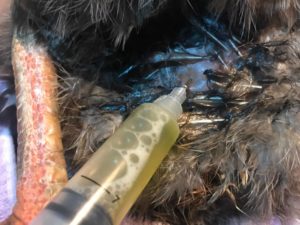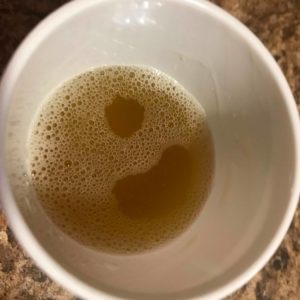Ascites in backyard chickens isn’t super common, but it’s possible you will come across this condition if you keep chickens.
Ascites isn’t really an illness itself. Rather, it’s a symptom that something is wrong with your chicken. According to the Merck Veterinary Manual, ascites is when fluid builds up in the peritoneal cavities of a chicken due to pulmonary hypertension and heart failure.
Sometimes it’s referred to as water belly or dropsy. The Chicken Health Handbook by Gail Damerow says the condition is more common in broiler chickens and aging layer hens.
What is ascites?
In broilers, the fast rate of growth these chickens experience typically causes the condition, according to Damerow. The immature heart and lungs simply can’t keep up with the demand, and the heart responds by pumping more blood into the lungs. This results in increased blood pressure between the heart and lungs. The rigid chicken lungs can’t handle the increased pressure, so the heart works harder to keep the blood pumping. Eventually, the heart enlarges and thickens until the right valve can no longer close. This results in blood backing up into the liver, and fluid from the liver leaks out into the body cavity.
In older layers, the condition is the same, but tumors, internal laying, genetic predisposition, poor ventilation, obesity, fungi and other toxins can be contributing factors. Chickens kept at high altitude can be more susceptible. Infections and moldy feed can also be factors.
The symptoms of ascites in backyard chickens can sometimes be mimic those of an eggbound hen. However, instead of having the more penguin-like stance of an eggbound hen, a hen with ascites will have a more wide-legged stance. This is because of the fluid-filled abdominal cavity.
Feeling the abdomen can often confirm the presence of fluid. The abdomen will feel squishy rather than firm like it would with an eggbound hen.
Ascites in backyard chickens is not contagious between birds. It is not curable. That’s because the underlying cause is heart disease. By the time things have progressed to the point where ascites is present, things are too far gone.
What can you do if your backyard chicken has ascites?

Pippy, a 4-year-old Wyandotte, presented recently with ascites.
I recently ran across my third case of ascites in my backyard flock. Pippy, my 4-year-old silver laced Wyandotte, presented with it recently. Her sister Poppy suffered from it several years ago. I suspect as a heavier breed of chicken that the Wyandotte might be more susceptible to the condition. I also had a red sex link hen that developed it a few years ago.
Pippy presented with the wide-legged stance along with lack of appetite and raspy breathing. I knew her time was limited, but as I’ve still been recovering from foot surgery, I was not quite ready to put her down.
Fortunately, there are some things you can do to try and prolong your hen’s life and make her more comfortable. As always, if you have a veterinarian in your area that treats poultry, that should be your first choice for treatment. However, if this isn’t an option, read on for how you can help your hen.
The most common way of relieving the discomfort of ascites in backyard chickens is to drain the fluid from the hen’s abdomen. It sounds scary, but is a relatively easy procedure with the right equipment.
As you will be penetrating the peritoneal cavity, everything needs to be very clean and sterile. Wear disposable gloves and make sure you use a sterile syringe and needle or catheter. The needle should be a large enough gauge to draw or drain fluid through.
Clean the hen’s abdomen on the right side down toward her vent area. I use isopropyl alcohol for this.

Feel the abdomen to tell where the fluid is. It will often be closer to the leg than to the middle of the body. Insert the needle at a slight angle to enter the peritoneal cavity without injuring any organs.
To drain the fluid, carefully insert the needle into the abdomen at a slight angle where you can feel that there is fluid. You want the needle to enter the peritoneal cavity, but you don’t want to jab it straight in. This will generally be closer to the leg than to the middle of the body.
Use the syringe to draw off about 4 or 5 ounces of fluid. You don’t want to draw off too much because that can send the hen into shock. If your syringe isn’t large enough to hold all the fluid, carefully remove the syringe from the needle, leaving the needle inserted in the hen. This will allow the fluid to drain on its own, but you should try to catch it in something so you can observe how much you are draining.

Use the syringe to draw off about 4 or 5 ounces of fluid to help provide relief to your hen. Just understand the relief is temporary and the process will likely have to be repeated. The underlying causes of ascites are generally incurable.
Note, if the fluid is anything other than a clear, pale yellow color, stop. Your chicken is suffering from something other than ascites.

When done, give the area another wipe with alcohol to clean it off. If possible, keep your hen somewhere where you can observe her for a while before returning her to the flock. Keep in mind you will most likely need to repeat this process – maybe in just a few days or maybe a few weeks. And remember that the underlying causes are generally not treatable.
I was able to remove about 4 ounces of fluid from Pippy and she immediately perked up and showed some appetite. I gave her a treat of softened oatmeal mixed with some plain Greek yogurt.
However, the improvement didn’t last long. The next day she was out and about with the flock, but for the next two days she didn’t even leave the coop.

Sadly, I couldn’t provide Pippy any real relief. Her condition was too far gone. Euthanizing her was the most humane option ultimately.
This morning, I made the decision to euthanize her rather than prolong her suffering. I still have three younger Wyandottes in my flock, and I will be watching the closely from now on for signs of this condition.
Traci DeLore grew up around chickens on her family’s farm, but didn’t start keeping her own chickens until she was in her 40s. Her desire to keep chickens came from a desire to have her own fresh eggs from chickens she knew were well cared for and happy. Traci started with six chickens – and then chicken math took over. These days, she has about 60 chickens — and three “rotten” ducks. (I say this because having ducks is like living with toddlers.) Traci also raises and processes her own meat chickens on occasion. Follow her on Instagram.












